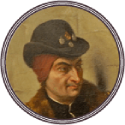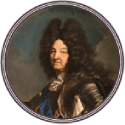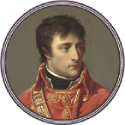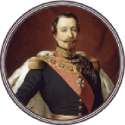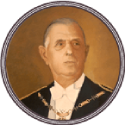France
Like mileposts in the construction of the nation, the major dates of orders and decorations follow the rhythms of French history, from the era of the crusades to our times.
Middle Ages
1113
Creation of the Sovereign Hospitaller Order of Saint John of Jerusalem, of Rhodes and of Malta
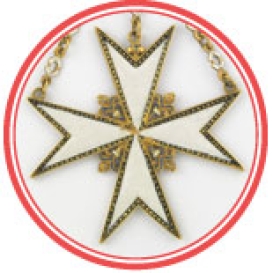
1348
Edward III founds the Order of the Garter
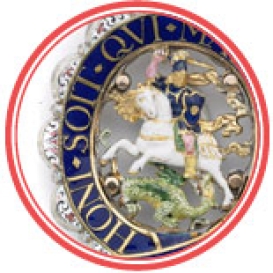
1351
John II of France founds the Order of the Star
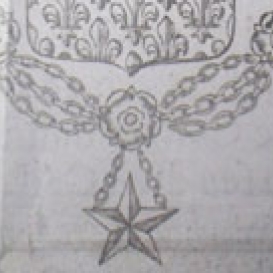
1430
Philip the Good, Duke of Burgundy founds the Order of the Golden Fleece
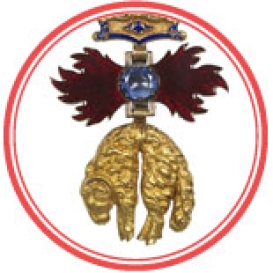
1469
Louis XI founds the Order of Saint Michael
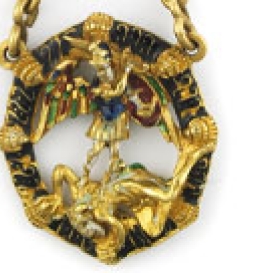
1578
Henry III founds the Order of the Holy Spirit
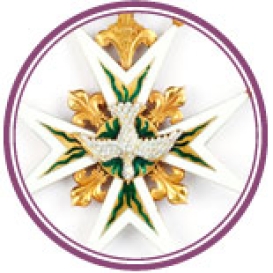
1608
Henry IV founds the united Orders of Our Lady of Mount Carmel and Saint Lazarus of Jerusalem
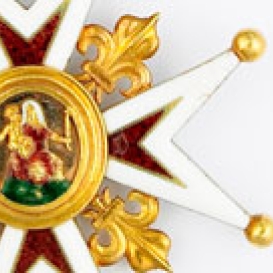
1693
Louis XIV founds the Order of Saint Louis
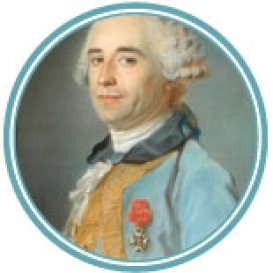
1759
Louis XV establishes the Institution of Military Merit and the Médaillon de Vétérance
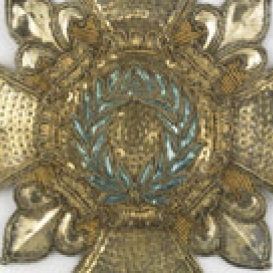
1799
Napoleon Bonaparte, First Consul, institutes the Weapons of Honor
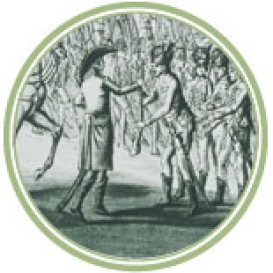
1802
Napoleon Bonaparte, First Consul, founds the Legion of Honor
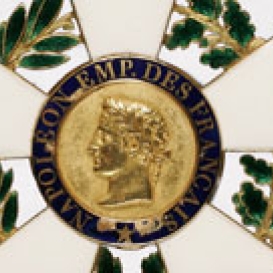
1805
Napoleon I initiates the Imperial orders of the Iron Crown and of the Reunion
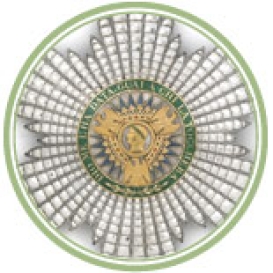
1852
Louis-Napoleon Bonaparte, Prince-President creates the Médaille militaire
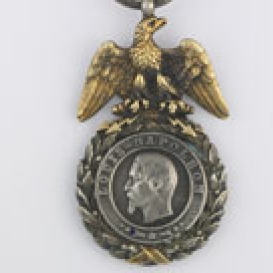
1857
Napoleon III inaugurates the Saint Helena Commemoratives Medal by and the principle of campaign medals
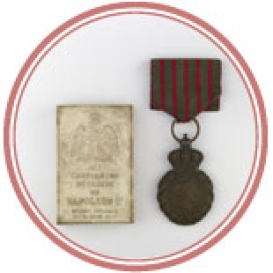
1883
The Order of Agricultural Merit and the principle of ministerial orders
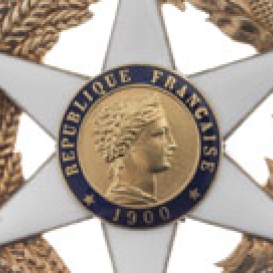
1896
The Royal Order of Cambodia, the Order of the Star of Anjouan, the Order of Nichan El-Anouar, the Order of the Dragon of Annam and the Order of the Black Star become French colonial orders
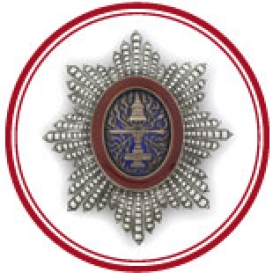
1915
The War Cross
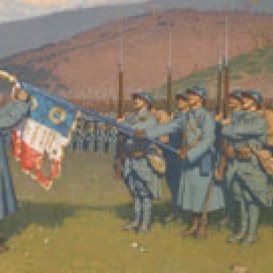
1963
President Charles de Gaulle founds the National Order of Merit
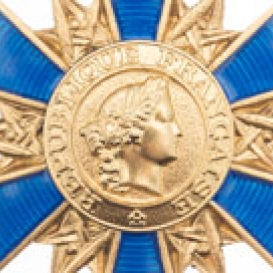
2016
Creation of the National Medal of Recognition for victims of terrorism
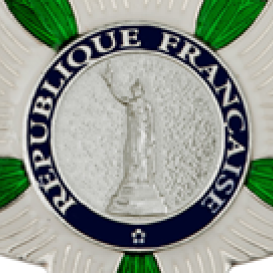
First Crusade 1096-1099
Hundred Years’ War 1337-1453
Hundred Years’ War 1337-1453
Hundred Years’ War 1337-1453
Hundred Years’ War 1337-1453
Wars of religion in France 1562-1598
Wars of religion in France 1562-1598
Reign of Louis XIV 1643-1715
Reign of Louis XV 1715-1774
Consulat 1799-1804
Consulate 1799-1804
First Empire 1804-1814
IIe République 1848-1852
Second Empire 1852-187
Third Republic 1875-1940
Third Republic 1875-1940
Third Republic 1875-1940
Fourth 1946-1958 and Fifth 1958- Republics
Fourth 1946-1958 and Fifth 1958- Republics
1113
Creation of the Sovereign Hospitaller Order of Saint John of Jerusalem, of Rhodes and of Malta
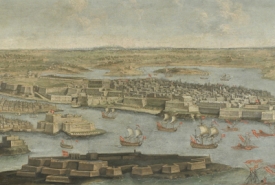
Religious and military orders, such as the Order of the Temple (Knights Templar) or the Order of Saint John of Jerusalem, appeared at the time of the Crusades. For the first time, communities of knights gathered around a grand master to create institutions that served an ideal.
The Order of Saint John of Jerusalem originated in a religious hospital foundation established at the Holy Sepulcher around 1050. After the Siege of Jerusalem in 1099, the foundation became a chivalric order with a two-fold mission: to care for the sick and to fight the infidels. The Crusader States disappeared in 1291 and in 1310 the knights settled in Rhodes, which became the bastion of Christendom thanks to its powerful fleet. Driven out in 1523 after a heroic siege, they were granted the island of Malta by the Holy Roman Emperor Charles V; there, they pursued their maritime and hospitaller missions.
Largely ruined by the French Revolution and driven out of its territory by Napoleon Bonaparte in 1798, the Order settled permanently in Rome in 1834. As in its early days, it became exclusively involved in hospital and charity missions. It is a sovereign State and the Order is present worldwide.
Insignia
The original insignia of the order was a white eight-pointed fabric cross sewn onto the knights’ cloaks. An enameled gold jewel appeared in the sixteenth century, which was standardized only at the end of the nineteenth century. The eight-pointed cross shape of this insignia inspired most of the French orders, from the Order of the Holy Spirit to the National Order of Merit.
1348
Edward III founds the Order of the Garter
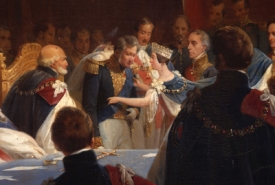
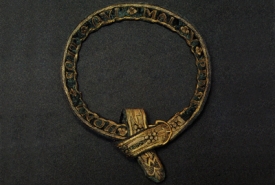
At the beginning of the Hundred Years’ War, c. 1348, the King of England, Edward III, claimed the French throne. He founded a political instrument of allegiance to his dynasty, the Most Noble Order of Saint George or of the Garter. The motto in French, Honi soit qui mal y pense (shame on him who thinks evil of it), and the blue and gold colors of the Order clearly indicate the Plantagenet’s claim to the kingdom of France. Its main characteristics, borrowed from chivalric and religious orders as well as from the legend of King Arthur and the Round Table, were adopted by almost all of the orders created during the sixteenth century. As such, it is considered to be the archetype of chivalric orders. It was awarded to nine French sovereigns: Francis I, Henry II, Charles IX, Henry III, Henry IV and in the nineteenth century, Louis XVIII, Charles X, Louis Philippe I and Napoleon III. It is still England’s most prestigious order.
1351
John II of France founds the Order of the Star
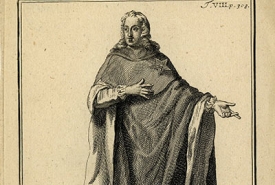
In 1351, King John the Good founded the Company of Knights of Our Lady of the Noble House, known as the Order of the Star, with the purpose of distinguishing a military elite in the difficult context of the Hundred Years War. The knights, who had sworn to never turn their backs on the enemy, were decimated in battle; thus the first French chivalric order did not survive the defeat of Poitiers in 1356. The insignia was a ring and a clasp adorned with a star.
1430
Philip the Good, Duke of Burgundy founds the Order of the Golden Fleece
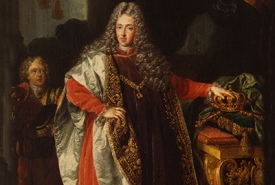
Philip III, the Duke of Burgundy, established the Order of the Golden Fleece in Bruges on January 10, 1430. This magnificent prince gathered an entourage of great lords around him, and affirmed his omnipotence over his cousin and sovereign, the King of France. He also asserted his independence from the King of England and his Order of the Garter, from which his own order was directly inspired. The symbolism of the new institution comes from the mythological story of Jason and his quest for the Golden Fleece.
The Order of the Golden Fleece was handed down to the House of Habsburg at the death of Duke Charles the Bold, and then to the Spanish monarchy by Charles Quint. After the War of the Spanish Succession, the order was divided into a Spanish Bourbon branch and an Austrian Habsburg branch.
Today the Spanish Golden Fleece is the highest distinction that the King of Spain may confer. The Austrian Order is considered a legal entity under international law.
Insignia
The insignia of the order is a collar with links representing fire strikers (the lighter of that period — Philip the Good’s personal emblem since 1421) and flints producing sparks. A ram’s hide, the legendary Golden Fleece, hangs from the collar. In daily life the insignia of the fleece is worn suspended from a red ribbon around the neck.
1469
Louis XI founds the Order of Saint Michael
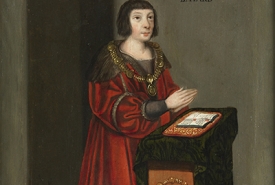
Louis XI founded the Order of Saint Michael in Amboise on August 1, 1469, to gather the elite of the kingdom around him and reassert his sovereignty over the powerful Duke of Burgundy and the King of England. Michael the Archangel, whose figure had adorned the royal standards since the Hundred Years’ War and whose Mount had never been conquered was chosen as the order’s patron saint.
Limited by statute to 36 men of noble birth bound by an oath of exclusive loyalty, the Order soon became the equal of its forerunners, the orders of the Garter and the Golden Fleece. Thanks to the political acumen of the King, it strengthened the prestige of the crown.
However, after the death of Henry II and due to the disorder of the religious wars, it began to be awarded excessively and thus lost some of its prestige. Reformed by Henry III when he founded the Order of the Holy Spirit, it became the second royal order of the kingdom.
King Louis XIV once again restructured the order in 1665 and used it as a token of his recognition for the great servants of the State in the fields of the arts, letters and sciences. Abolished in 1791, it was reinstated by Louis XVIII, and finally discontinued by Louis Philippe I in 1830.
Insignia
The insignia was composed of a badge depicting Saint Michael the Archangel slaying the dragon suspended from a collar made of scallop shells linked together by knots. The Knights were required to wear the collar daily. In private or when hunting they were allowed to wear the pendant alone hung from a simple chain or a silk lace: the Small Order. In 1665, Louis XIV had the pendant replaced with a cross to be worn on a black ribbon. It is similar to the cross of the knights of the Holy Spirit but with the effigy of Saint Michael the Archangel on both sides.
1578
Henry III founds the Order of the Holy Spirit
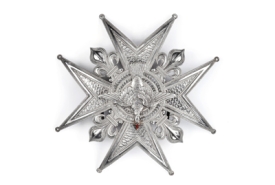
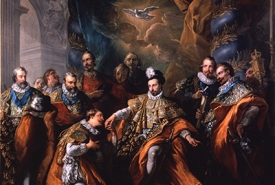
The most prestigious order of the French monarchy, the Order of the Holy Spirit, was founded by Henry III on December 31, 1578. The sovereign, who became King of Poland, then King of France during the feasts of Pentecost in 1573 and 1574, showed his devotion to the Holy Spirit by naming the order after it.
Designed to defend the Catholic religion, it was also made to secure the loyalty of the kingdom’s elite, which had been divided by the Catholic League, to the King. The Order of Saint Michael could no longer play this unifying role as it had been had been too largely conferred by Charles IX.
The order was composed of one hundred noble Catholic knights appointed by the king, who were also knights of Saint Michael. It ceased to be awarded in 1789, was abolished in 1791, reinstated under the Restoration, and finally discontinued in 1830 by Louis Philippe I.
Insignia
The statutes provide for a number of different insignia: the collar, reserved for ceremonies, was worn over a mantle; the dove of the Holy Spirit appears on the obverse side of a Maltese cross and Saint Michael the Archangel appears on the reverse side; an embroidered badge is sewn onto the coat. The ribbon is sky blue.
1608
Henry IV founds the united Orders of Our Lady of Mount Carmel and Saint Lazarus of Jerusalem
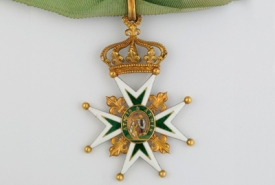
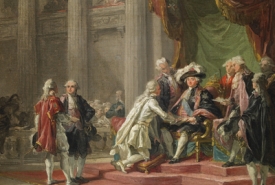
In 1608, Henry IV, as a token of the sincerity of his conversion to Catholicism, founded the Order of Our Lady of Mount Carmel. He united it with the ancient Order of Saint Lazarus, founded at the time of the Crusades to care for lepers. It fell into disuse but was still rich with property. The last grand master was the Count of Provence. He did not restore the united orders when he became King Louis XVIII with the Restoration so it died out.
Insignia
The insignia of the order was an eight-pointed cross with the image of the Virgin Mary on one side and Saint Lazarus on the other. It was accompanied by an embroidered badge. The Count of Provence had the amaranth ribbon changed to green at the end of the eighteenth century.
1693
Louis XIV founds the Order of Saint Louis
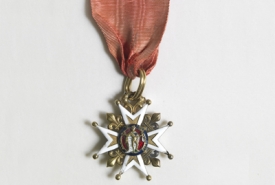
Louis XIV established the Order of Saint Louis on April 5, 1693 in Versailles, to reward virtue, merit and distinguished service of Catholic officers of the royal army who had served for more than ten years. The King thus created a new chivalry based on military merit; nobility was not a requirement for entry into the order.
Ranks were instituted: Knights, in numbers at the discretion of the Grand Master, Commanders and Grand Cross in limited numbers.
The Order of Saint Louis was the first order to recognize merit democratically and it became immensely prestigious in the armies. It was Napoleon Bonaparte’s model for the creation of the Legion of Honor. It was briefly maintained during the Revolution under the name of Military Decoration and was abolished on October 15, 1792. Louis XVIII restored it and, like all the other orders of the Ancien Régime, Louis Philippe I put it to sleep.
Insignia
The cross of Saint Louis, worn on the lapel of the suit jacket on a fire red ribbon, is similar to the cross of the Holy Spirit. The figure of Saint Louis is in the center; a palewise sword interlaced with a laurel wreath and the motto of the Order by Boileau: Bellicae virtutis praemium (reward for military valor) is on the back. Commanders and Grand Cross are distinguished by a larger cross worn on a sash; a badge for the Grand Cross.
1759
Louis XV establishes the Institution of Military Merit and the Médaillon de Vétérance
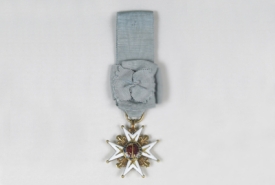

The Institution of Military Merit
Louis XV founded the Institution of Military Merit on May 10, 1759, in order to reward the valor of the Protestant foreign officers serving him. It copies the Order of Saint Louis, without the religious dimension. Its history is merged with that of the Order of Saint Louis.
Insignia
Derived form the cross of Saint Louis, the insignia of Military Merit has the palewise sword on the obverse and the laurel wreath on the reverse.
Médaillon de Vétérance (Veteran’s Medal)
Louis XV created a distinctive recognition of non-commissioned officers and soldiers who served him for more than 24 years, on April 16, 1771. The Medal of Veterancy was awarded in front of the entire regiment, along with an award certificate and an oath of loyalty to the King. The Revolution did not abolish this distinction, which was still awarded at the beginning of the First Republic.
Insignia
The insignia consists of two crossed swords on a woolen cloth background, initially in the color of the uniform, then red. Illustrations
1799
Napoleon Bonaparte, First Consul, institutes the Weapons of Honor
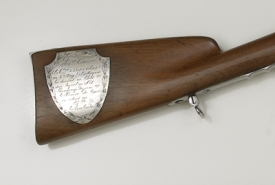
The Weapons of Reward was the predecessor of the institution of the Legion of Honor. The Directory recognized the need for national rewards, at least for military service, and began awarding signed weapons or flags in 1796. The number of weapons so awarded increased when Napoleon Bonaparte took command of the Italian armed forces: in 1797 he took the initiative of having one hundred name-bearing sabers made in Milan, with the inscription Army of Italy, given by General Bonaparte on behalf of the Executive Directory of the French Republic. The use of these rewards was codified by the commander-in-chief during the Egyptian campaign on February 2, 1799. One of the Directory’s last actions was to officially institute the Récompenses Nationales on October 3, 1799. As First Consul, Napoleon Bonaparte founded the Weapons of Honor based on these provisions, on December 25, 1799.
The name-bearing weapons, awarded with a certificate signed by the First Consul, were divided into two classes:
- sabers, for officers and soldiers who carried out outstanding exploits;
- different weapons, depending on the position of the recipient: guns for grenadiers and soldiers; carbines for cavalry; drumsticks for drummers; trumpets for trumpeters; grenades for cannoneers, to be sewn on the uniform; boarding axes for sailors, to be fastened to the harness.
The weapon recipients (around 2000) were ex officio members of the Legion of Honor and constituted the first cohort on September 24, 1803.
1802
Napoleon Bonaparte, First Consul, founds the Legion of Honor
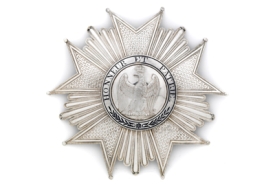
Napoleon Bonaparte founded the Legion of Honor on May 19, 1802, to unite military courage and civilian talent into one elite corps, and build the foundation of a new society in the service of the nation. Modern in its universality, traditional in its organization, the institution epitomized the visionary genius of its founder.
A grand chancellor (Comte de Lacépède) was put in charge of the administration of the order, under the authority of the head of the Legion of Honor (the Head of State). The Legion was first divided into sixteen cohorts (dropped in 1809). The institution was composed of four ranks: legionnaire (called “Knight” as of 1808), Officer, Commander and Grand Officer.
In 1804, Napoleon, now emperor, established the insignia: a star with his effigy and the imperial eagle on the reverse with the motto Honneur et Patrie (honor and homeland). In 1805 the supreme title was created, the Grand Decoration, which was exchanged with the orders of European monarchies. The Emperor held the first two solemn award ceremonies at the Invalides and at the Camp de Boulogne on July 15 and then on August 16, 1804.
The Legion of Honor became an integral part of the history of the nation. Retained by Louis XVIII under the Restoration, it coexisted with the royal orders without losing its prestige. The profile of Henry IV and the fleurs-de-lis replaced the Emperor’s profile in the center of the insignia.
It became the sole national order under the July Monarchy; the tricolor flag was added to the reverse of the badge.
It became more present in a society undergoing profound changes. Napoleonic symbolism reappeared on the insignia during the Second Republic and the Second Empire. Women were finally admitted which further extended its universality. The Third Republic gave its roots in the republican tradition and the Great War gave it a glorious popularity. Finally, the Code of 1962 restored the Order’s rigor while adapting the institution to the contemporary world, forming its definitive structure.
1805
Napoleon I initiates the Imperial orders of the Iron Crown and of the Reunion
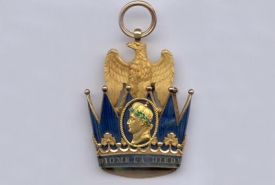
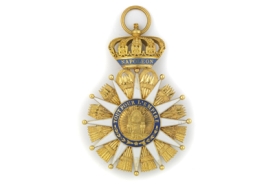
Order of the Iron Crown
The Order of the Iron Crown was founded on June 5, 1805, by Napoleon, King of Italy, who wore the insignia next to the Legion of Honor. An allusion to the crown of the Kings of the Lombards, said to contain the melted metal from a nail of the True Cross, this order was established to reward civil and military services rendered to the Italian crown. The Emperor paid attention to the insignia: an antique crown and the motto Dieu me l’a donnée, gare à qui la touche (God gave it to me; who touches it, beware). The ribbon was orange edged with green. It became an Austrian reward in 1814, and members had to trade in their insignia for a substitute jewel.
Order of the Reunion
Subsequent to the extension of the Empire, the Order of the Reunion was founded by Napoleon on October 18, 1811, to be second to the Legion of Honor and replace all the orders of the annexed territories. The decoration symbolically illustrates the reunion [to the Empire] of Holland, the Hanseatic cities, Rome and Tuscany. The reverse contains the letter N and the motto A jamais (forever). Louis XVIII abolished this order on July 28, 1815. Illustrations
1852
Louis-Napoleon Bonaparte, Prince-President creates the Médaille militaire

As Napoleon Bonaparte had done in 1802, the then Prince-President Louis-Napoleon Bonaparte associated himself with a reward institution by creating the Médaille militaire (Military Medal) on January 22, 1852.
This military medal was above all intended for the troops, too often ignored by the Legion of Honor. It has also been, by way of exception, since May 10, 1852 (date when marshals Reille and Vaillant received it), the supreme honor conferred upon victorious war leaders. This exceptional measure largely contributed to the popularity of the new insignia. A Republican order since September 4, 1870, it adapted to the requirements of its times, and its history faithfully follows the military events of France up to today. The Médaille militaire rewards both extraordinary feats in combat as well as lengthy service in the armed forces. It may be awarded to non-French citizens.
Insignia
The insignia, silver by statute, is worn on a yellow and green ribbon, the colors of Napoleon’s Order of the Iron Crown. The portrait of the Prince-President, set in a laurel wreath, and the inscription Louis-Napoléon figures on the obverse of the medallion. An eagle with outstretched wings holding a suspension ring surmounts it. The motto, Valeur et Discipline (Valor and Discipline) is engraved on the reverse. It was modified on November 8, 1870, so as to adjust to political changes. The Republic is represented by Ceres, topped by a trophy and the inscription République Française, 1870. This date was deleted in 1951 and replaced by a floral motif.
1857
Napoleon III inaugurates the Saint Helena Commemoratives Medal by and the principle of campaign medals
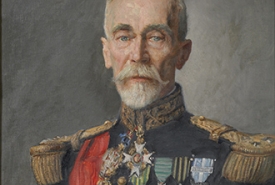
The principle of a commemorative medal is that it is awarded to any officer or soldier who served during a given campaign; it is not a reward for noteworthy action. Napoleon III, inspired by British uses, introduced this type of medal to France after the Crimean War. The Saint Helena Medal, established by decree dated August 12, 1857, was France’s first commemorative medal. Conferred to all veterans of the Revolution and Empire armies, it replaced many unofficial veterans’ insignias.
Insignia
The bronze medal, designed by Désiré Albert Barre, Chief Engraver of the Paris Mint, is topped by an imperial crown, and hangs from a green ribbon with five red stripes. On the obverse, the laurel-crowned profile of Napoleon I with the inscription Napoléon empereur; on the reverse: A ses compagnons de gloire, sa dernière pensée – Sainte-Hélène 5 mai 1821 (To his companions in glory, his last thoughts – Saint Helena, May 5, 1821) plus the epigraph Campagnes de 1792 à 1815 (Campaigns of 1792-1815).
Following the Second Empire’s campaigns, three medals —Italy (1859), China (1861) and Mexico (1863)— were created by decision of Napoleon III. They were also made by Désiré Albert Barre on the same model, bearing on the obverse the laurel-crowned bust of the Emperor and on the reverse the names of the main battles of his campaigns. The governments of the Republic kept up the tradition of commemorative medals:
-Commemorative medals of the main colonial expeditions: Tonkin (1885), Madagascar (1886 and 1896), Dahomey (1892), China (1901), and Morocco (1909).
-Colonial medal: created in 1893; French Overseas Medal as of 1962.
-Commemorative medals of conflicts: Franco-Prussian War of 1870, World Wars, Indochina, North Africa, etc. The most recent one is the Medal of the Nation’s Gratitude (Médaille de la Reconnaissance de la Nation), created en 2002.
1883
The Order of Agricultural Merit and the principle of ministerial orders
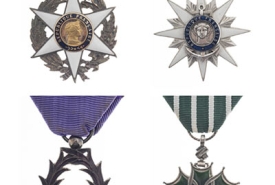
The Order of Agricultural Merit (Ordre du Mérite agricole), devised in the broadest democratic spirit, was created by decree on July 7, 1883, to honor the devoted servants of agriculture. The Minister of Agriculture, Jules Mélines, sought to institute the equivalent of the Legion of Honor for farmers who were rarely nominated in the Legion of Honor. Originally a one rank order, the rank of Officer was instituted in 1887, and Commander in 1900.
Agricultural Merit is the prototype of special ministerial orders of merit, which abounded under the Third and Fourth Republics on the initiative of various ministries: Maritime Merit (February 9, 1930), Social Merit (October 25, 1936), Order of Public Health (February 18, 1938), Commercial Merit (May 27, 1939) modified as Commercial and Industrial Merit (June 29, 1961), Artisanal Merit (June 11, 1948), Tourism Merit (May 27, 1949), Combatant Merit (September 14, 1953), Postal Merit (November 14, 1953), National Economy (January 6, 1954), Sports Merit (July 6, 1956), Work Merit (January 21, 1957), Military Merit (March 22, 1957), Order of Arts and Letters (May 2, 1957), Civil Merit (October 14, 1957), Saharan Merit (April 4, 1958).
The Academic Palms is a unique order that began as an employment-related insignia when first established on March 17, 1808 with the reorganization of the universities by Napoleon I. The order became a permanent decoration under the Second Empire, and, by decree of October 4, 1955, became a ministerial order with three traditional ranks.
Most of these special orders ceased to be awarded on January 1, 1964, soon after the National Order of Merit was founded, with the exception of four orders: the Academic Palms and Agricultural Merit – not included in the reform; the Maritime Merit and Arts and Letters —retained at the last minute.
1896
The Royal Order of Cambodia, the Order of the Star of Anjouan, the Order of Nichan El-Anouar, the Order of the Dragon of Annam and the Order of the Black Star become French colonial orders
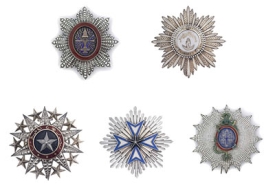
On May 10, 1896, as part of its colonial expansion, France undertook to use the orders of five countries placed under its protection:
- Royal Order of Cambodia, founded by Norodom I in 1864;
- Order of the Star of Anjouan, founded par Saidi Ben Salem en 1874; • Order of Nichan El-Anouar (Order of the Light), founded by the Sultan of Tajurah in 1887;
- Order of the Black Star, founded by the King of Porto-Novo in 1892;
- Order of the Dragon of Annam, founded by Emperor Dong-Khanh in 1896.
Thenceforth awarded by the President of France or by the protected authority, these orders rewarded at least nine years of services rendered in the colonies by Europeans, natives and metropolitans engaged in colonial expansion.
After World War II, the Royal Order of Cambodia and the Order of the Dragon of Annam were returned to their respective countries. The other three became the French Overseas Orders. They were discontinued when the National Order of Merit was founded in 1963.
1915
The War Cross
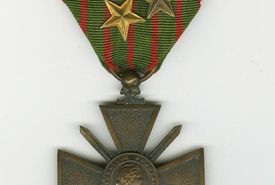
At the beginning of the First World War, the only rewards available to combatants in France were the Legion of Honor and the Military Medal. Since this array appeared insufficient, Maurice Barrès was one of the first to call for a bronze medal for the brave to reward soldiers on the battlefield. The law of April 8, 1915, put forward by commander Driant, created a War Cross intended to honor individual citations.
Conferred to both military and civilian individuals who had received the necessary citations, and exceptionally to local authorities, it ceased being granted after October 28, 1921. The number of War Crosses is estimated at 1.2 million for the Allies as a whole (representing more than 2 million citations).
In addition, a large number of decorations and commemorative medals came into existence during and especially after the conflict, including the Inter-Allied Victory Medal, made by all the Allies in 1921.
Insignia
The War Cross is a bronze Maltese cross with two crossed swords bearing the image of the Republic on the obverse and on the reverse 1914 and the year of distinction: 1915, then 16, 17, 18. The green ribbon striped with red, inherited from the Medal of Saint Helena, evokes Napoleonic glory. The distinctions are represented on the ribbon by a star (bronze for brigade and regiment level, silver for division, vermeil for corps) and/or a bronze palm leaf for honors at the army level. The War Cross was the model for crosses founded in the context of later conflicts:
- Cross of War for Foreign Operational Theaters (TOE), founded on April 30, 1921, to honor individual citations obtained in foreign theaters of operation after November 11, 1918.
- War Cross 1939-1945
- Cross of Military Valor, founded on April 11, 1956, in the context of operations undertaken in Algeria, and still granted (as in Yugoslavia in 1992).
1963
President Charles de Gaulle founds the National Order of Merit
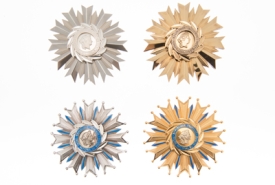
The creation of a second national order was the centerpiece of the reform of French decorations undertaken by General Catroux, Grand Chancellor of the Legion of Honor, beginning in 1956. This reform was carried out thanks to the personal involvement of Charles de Gaulle after his election as President of the Republic in 1958.
It was a question of restoring the Legion of Honor back to its full prestige and distinctiveness as well as of simplifying the system of specialized awards. After years of preparatory work, the decree founding the National Order of Merit was officially signed on December 3, 1963.
Its organization was based on that of the Legion of Honor, reformed by the new code promulgated a year earlier, on November 28, 1962. The order’s vocation is to reward a select younger group, thanks to a less demanding period of distinguished services —ten years instead of twenty years of eminent services for the Legion of Honor. The order thus accommodated greater flexibility and was able to adapt to the requirements of the contemporary world.
The National Order of Merit replaced sixteen orders: the three orders of Overseas France and the thirteen specialized orders of ministries.
Insignia
The insignia of the National Order of Merit, created by Max Léognany, is clearly inspired by the insignia of the Legion of Honor: a bifid star in blue enamel and with a sixth branch. The center, surrounded by crossed laurel leaves, bears the effigy of the Republic on the front side with the inscription République française. The reverse has two tricolor flags with the inscription Ordre national du Mérite and the date of its creation. The insignia is suspended from a French blue ribbon, echoing the first name proposed for the order: the Merit of France. The center, originally unicolor metal, was modified on January 21, 1980.
2016
Creation of the National Medal of Recognition for victims of terrorism
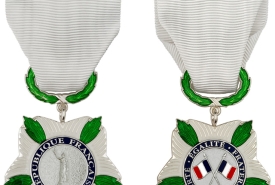
It was created after the terrorist attacks that took place in Paris and Saint-Denis in November 2015 and after those in January of the same year that had already brutalized France and violated the freedom of expression. These events gave rise to great emotion nationwide and made evident a need to honor the victims of terrorism, pointing out a previous gap in the French award system.
The National Medal of Recognition is designed to pay tribute to victims of terrorist attacks against France. It is therefore a special type of award, since it is not intended as a reward for services rendered to the nation. It was created by decree on July 12, 2016, by François Hollande, President of the Republic, on a proposal from the Grand Chancellor of the Legion of Honor.
Insignia
The National Medal of Recognition for victims of terrorism is a white flower with five petals separated by olive leaves, attached to a white ribbon. On the obverse, it bears the statue of the Place de la République in Paris, with the inscription « République française » (French Republic); on the reverse, it depicts two crossed French flags and the national motto « Liberté-Egalité-Fraternité » (Liberty-Equality-Fraternity).
